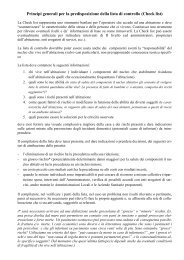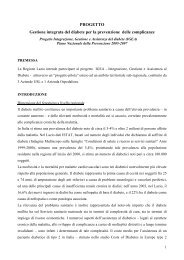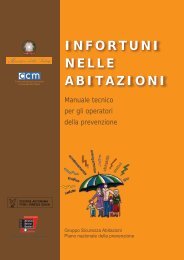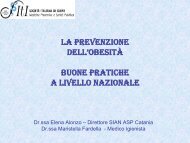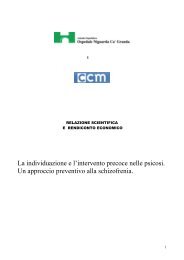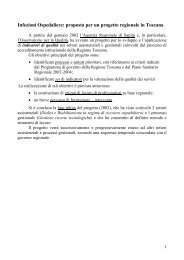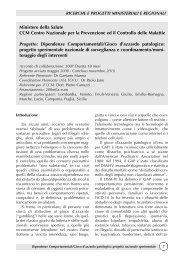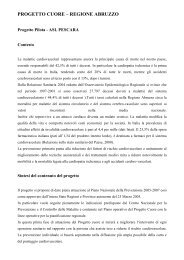Gaining health : analysis of policy development in European ...
Gaining health : analysis of policy development in European ...
Gaining health : analysis of policy development in European ...
You also want an ePaper? Increase the reach of your titles
YUMPU automatically turns print PDFs into web optimized ePapers that Google loves.
Chapter 4<br />
138<br />
• positive changes <strong>in</strong> lifestyle (<strong>in</strong> terms <strong>of</strong> smok<strong>in</strong>g, alcohol<br />
use, overweight and physical activity);<br />
• decl<strong>in</strong><strong>in</strong>g avoidable mortality;<br />
• a lower <strong>in</strong>cidence <strong>of</strong> acute myocardial <strong>in</strong>farction and<br />
stroke;<br />
• a decl<strong>in</strong><strong>in</strong>g number <strong>of</strong> disabled people and improved<br />
quality <strong>of</strong> life;<br />
• an <strong>in</strong>crease <strong>in</strong> well-diagnosed and treated cardiovascular<br />
patients, a reduction <strong>in</strong> the high-risk population and an<br />
<strong>in</strong>crease <strong>in</strong> successful rehabilitation; and<br />
• a reduction <strong>in</strong> cardiovascular morbidity and mortality <strong>in</strong><br />
younger and middle-aged people.<br />
The conceptual framework <strong>of</strong> the Programme puts special<br />
emphasis on <strong>health</strong> promotion, on the lists <strong>of</strong> <strong>in</strong>dicators<br />
accord<strong>in</strong>g to the <strong>European</strong> Community Health Indicators<br />
(ECHI) system and the creation <strong>of</strong> a coherent database.<br />
The document underl<strong>in</strong>es the importance <strong>of</strong> PHC <strong>in</strong> the<br />
community.<br />
The document makes clear reference to other exist<strong>in</strong>g<br />
policies and programmes, <strong>in</strong>clud<strong>in</strong>g the NPHP, the National<br />
Cancer Control Programme and others, without mak<strong>in</strong>g<br />
clear its own added value. The key people <strong>in</strong> the plann<strong>in</strong>g<br />
group may have an important lobby<strong>in</strong>g function for secur<strong>in</strong>g<br />
f<strong>in</strong>anc<strong>in</strong>g from the EU structural funds <strong>in</strong> the period <strong>of</strong> implementation<br />
up to 2013. At the moment, the Programme<br />
has no clear legal status or managerial structure.<br />
2.7. Policies related to risk factors<br />
There are clear-cut sub-policies for tobacco control and<br />
nutrition. The alcohol <strong>policy</strong> is <strong>in</strong> a preparatory phase. A<br />
strategy on leisure time physical activity is <strong>in</strong>cluded <strong>in</strong> the<br />
document outl<strong>in</strong><strong>in</strong>g the National Sport Strategy.<br />
2.7.1. Tobacco<br />
Physicians <strong>in</strong> Hungary – reflect<strong>in</strong>g <strong>in</strong>ternational trends –<br />
started to call attention to the devastat<strong>in</strong>g results <strong>of</strong> smok<strong>in</strong>g<br />
<strong>in</strong> the early 1980s (4).<br />
Studies on the social and economic costs <strong>of</strong> smok<strong>in</strong>g show<br />
that from 1995 on, direct and <strong>in</strong>direct costs <strong>in</strong>creased cont<strong>in</strong>uously,<br />
exceed<strong>in</strong>g by about three times state revenues<br />
from the tobacco sector. Direct smok<strong>in</strong>g-related costs,<br />
<strong>in</strong>clud<strong>in</strong>g hospital care, disability pensions and subsidies on<br />
pharmaceutical products, accounted for around 10% <strong>of</strong> the<br />
total costs to the national Health Insurance Fund <strong>in</strong> all three<br />
years for which calculations were made.<br />
The NPHP lists tobacco control among its most important<br />
programme elements. With<strong>in</strong> this framework, the 10-year<br />
National Antismok<strong>in</strong>g Action Plan states as its overall priority<br />
to reduce smok<strong>in</strong>g <strong>in</strong> Hungary by 8% every year.<br />
With the ratification <strong>of</strong> the WHO FCTC <strong>in</strong> 2003, the<br />
Hungarian Government assumed responsibility for creat<strong>in</strong>g<br />
the <strong>in</strong>stitutional framework for develop<strong>in</strong>g and implement<strong>in</strong>g<br />
programme elements. The implementation <strong>of</strong> the FCTC<br />
is <strong>in</strong> progress and a ban on cigarette advertis<strong>in</strong>g has been<br />
<strong>in</strong>troduced. Steps have been taken to provide smoke-free<br />
environment for the public, such as a ban on smok<strong>in</strong>g <strong>in</strong><br />
public build<strong>in</strong>gs. The media pay <strong>in</strong>creas<strong>in</strong>g attention to the<br />
issue and public acceptance <strong>of</strong> smok<strong>in</strong>g has decl<strong>in</strong>ed significantly<br />
<strong>in</strong> the last few years.<br />
Several anti-tobacco campaigns have been developed and<br />
run <strong>in</strong> the last 20 years, aim<strong>in</strong>g to draw the population’s<br />
attention to the negative effects <strong>of</strong> smok<strong>in</strong>g on their <strong>health</strong><br />
and quality <strong>of</strong> life. Campaigns are designed and carried out<br />
by the M<strong>in</strong>istry <strong>of</strong> Health and the National Institute for<br />
Health Development. Different programmes are designed<br />
for smokers, to make them aware <strong>of</strong> the dangers <strong>of</strong> smok<strong>in</strong>g<br />
and encourage them to quit, while others are designed<br />
to prevent young people tak<strong>in</strong>g up smok<strong>in</strong>g (5).<br />
One <strong>of</strong> the most widespread cessation campaigns is the<br />
“Quit and W<strong>in</strong>” programme, which is part <strong>of</strong> the CINDI<br />
framework activity <strong>in</strong> Hungary. The programme was<br />
launched <strong>in</strong> 1998, and events were organized <strong>in</strong> every two<br />
years (6). A number <strong>of</strong> active NGOs, <strong>in</strong>clud<strong>in</strong>g the National<br />
Case studies: <strong>policy</strong> <strong>development</strong> <strong>in</strong> countries for tackl<strong>in</strong>g noncommunicable diseases



